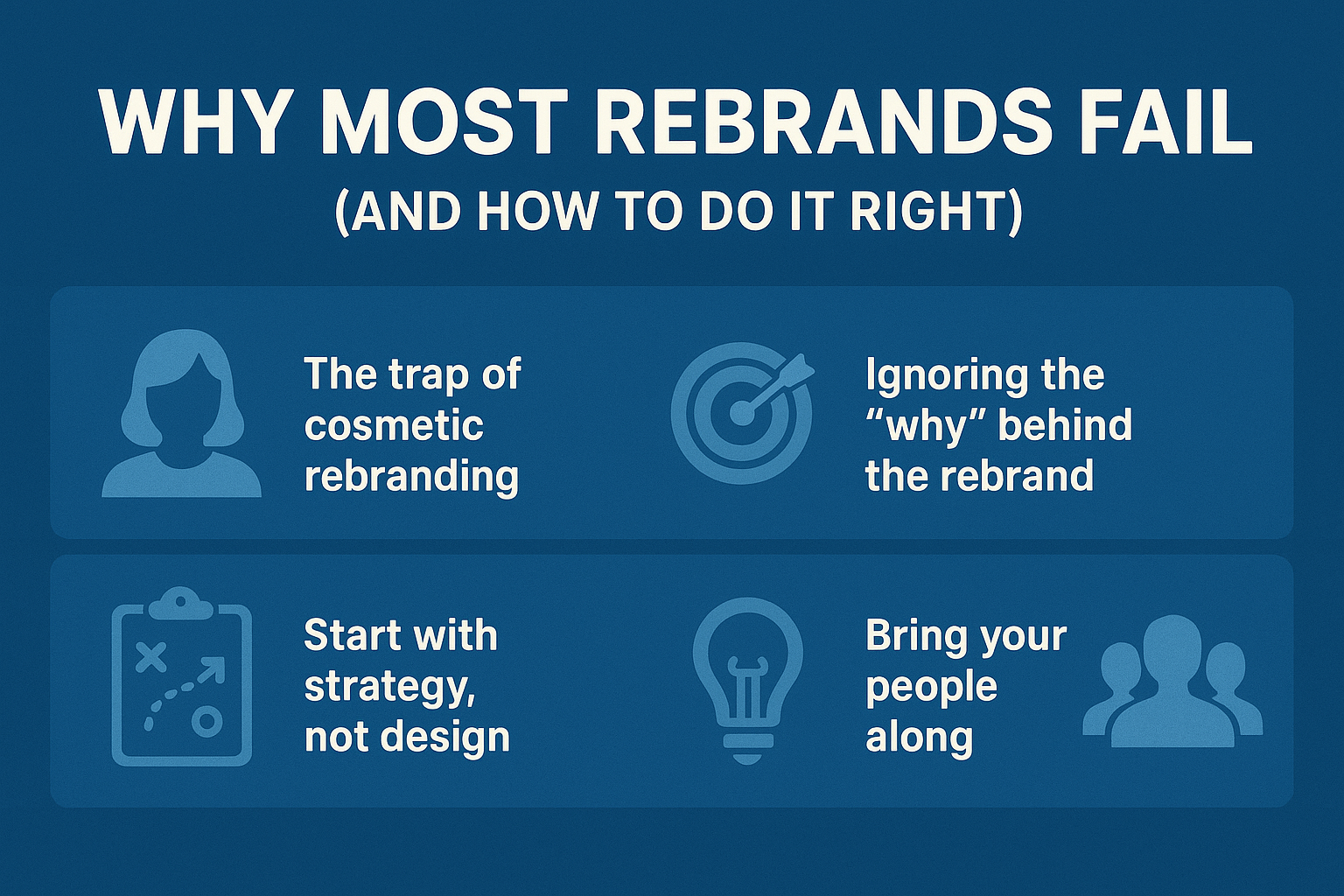Table of Contents
- The Trap of Cosmetic Rebranding
- Ignoring the “Why” Behind the Rebrand
- Forgetting the Audience
- Overlooking Internal Alignment
- How to Rebrand the Right Way
- Closing Thoughts
Rebranding is one of the most powerful tools in a company’s growth playbook. Done well, it breathes new life into a business, strengthens connections with audiences, and positions the brand for the future. Done poorly, it becomes an expensive exercise in changing logos and taglines while leaving the core problems untouched.
So why do most rebrands fail? The truth is that too many companies mistake cosmetic updates for real transformation. Let’s break down where rebrands go wrong—and how to make sure yours doesn’t.
The Trap of Cosmetic Rebranding
The most common mistake in rebranding is treating it like a design project instead of a business strategy. Swapping out colors, fonts, and logos can make your brand look fresh, but if the essence of your brand—its values, culture, and promise to customers—remains unclear, the rebrand will feel hollow.
Think about it this way: painting the walls of a crumbling house doesn’t fix the foundation. Customers can sense when a rebrand is surface-level, and that disconnect quickly erodes trust.
Cosmetic rebrands also risk confusing loyal customers. If a long-standing brand suddenly looks completely different without explanation, it creates uncertainty: “Is this the same company I trusted before?” A strong rebrand explains the evolution, showing continuity between the past and the future instead of erasing what people already value.
Ignoring the “Why” Behind the Rebrand
Too often, companies rush into rebranding because they feel outdated, want to keep up with competitors, or believe a new look will solve declining sales. But without a clear reason rooted in strategy, a rebrand becomes directionless.
Ask yourself:
- Are we rebranding to reflect a new vision or business model?
- Are we trying to reach a new audience?
- Are we correcting a mismatch between who we are and how we’re perceived?
If the “why” isn’t strong enough, no design overhaul will save the effort.
The best rebrands are purposeful. For example, when a company expands from a niche product into a diversified service provider, the old identity might no longer capture its true scope. In such cases, rebranding communicates growth, maturity, and alignment with new goals. Without that strategic anchor, however, a rebrand risks becoming a costly distraction rather than a catalyst for change.

Forgetting the Audience
Another pitfall: focusing inward instead of outward. Leadership teams often fall in love with a sleek new identity without asking whether it resonates with customers. At its core, a brand is a relationship between your business and your audience. If you don’t bring your customers into the process—through research, feedback, and testing—you risk launching a rebrand that confuses or alienates them.
Successful rebrands are built on empathy. They reflect not only who you are, but also what your audience values most about you. When you involve customers, you uncover surprising insights: perhaps they value your reliability more than your innovation, or your heritage more than your modernity. Ignoring these truths can create a disconnect that damages loyalty.
In today’s digital world, audiences are vocal and quick to judge. A tone-deaf rebrand can backfire within hours on social media. By listening closely and aligning with customer expectations, you minimize backlash and strengthen your brand’s credibility.
Overlooking Internal Alignment
Even the best-designed rebrand will fail if your employees don’t understand or believe in it. Your team is your brand’s first audience. If they don’t live and breathe the new identity, it won’t stick in the marketplace.
A true rebrand is a cultural reset. It requires internal communication, training, and storytelling that bring the new brand to life across every department. From customer service to sales, every touchpoint needs to align with the new promise.
When employees feel disconnected from the rebrand, they send mixed messages to customers. That inconsistency undermines trust and weakens the impact of the entire effort. But when employees are engaged—when they feel proud of the story, visuals, and mission—they become brand ambassadors who naturally spread the new identity.
Companies that succeed at rebranding don’t just roll out a new logo—they invest in internal buy-in first. Workshops, brand guidelines, and leadership modeling help ensure that the transformation is embraced across the organization.
How to Rebrand the Right Way
So, what does success look like? Here are the non-negotiables for a rebrand that actually works:
1. Start with Strategy, Not Design
Define your brand’s purpose, values, and unique positioning before you even think about visuals. Design should be the expression of strategy, not a substitute for it. This approach ensures that your rebrand has depth and direction, not just aesthetic appeal.
2. Anchor in a Clear “Why”
Establish the business case for rebranding. Is it growth, repositioning, reputation recovery, or cultural evolution? The why keeps everyone focused. When the reason is compelling and well-communicated, both internal teams and customers understand the value behind the change.
3. Put the Customer at the Center
Use research, surveys, and interviews to understand what matters most to your audience. Rebranding should strengthen, not disrupt, that connection. Think of the rebrand as a bridge between your company’s aspirations and your customers’ expectations.
4. Bring Your People Along
Involve employees early and equip them to embody the new identity. When they believe in it, customers will too. Consider launching internal campaigns that explain the brand’s story, celebrate its values, and invite employees to contribute to shaping its voice.
5. Think Beyond the Launch
A rebrand isn’t a one-day event. It’s a long-term commitment to living the new identity consistently—in messaging, design, service, and culture. The most successful rebrands unfold over months and years, reinforced by continuous storytelling, marketing campaigns, and consistent brand experiences
Closing Thoughts
Most rebrands fail because they stop at the surface. True transformation requires digging deeper: aligning your identity with your strategy, culture, and audience. When done right, a rebrand doesn’t just change how you look—it changes how you’re remembered.
If your business is considering a rebrand, resist the urge to start with the logo. Start with the heart.




